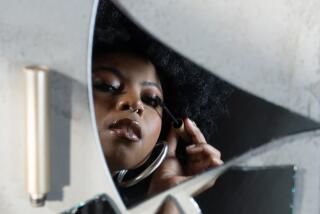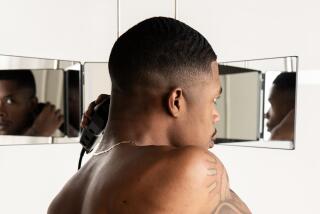STYLE : LOOKS : Letting Our Hair Down
- Share via
Back in the 1950s, when I was just a child and black people were still Negroes, you could be sure of three things. One and two were the much-ballyhooed death and taxes. The third was this: A Negro woman, regardless of her age or station in life, always carried a little plastic rain bonnet. Unlike boots or slickers, it guaranteed that her hair would be protected from moisture. Because the one thing she did not want her hair to do was get wet and “go back”--as in back to its natural, unstraightened state.
In those days, black women went to great lengths to avoid kinky hair. Many, for instance, went to the beach but didn’t go in the water--unless protected by layers of rubber swimming caps. Strenuous activity also was avoided because you didn’t want to “sweat your hair out.”
In retrospect, it was an awfully repressed way to live. But then, the ‘50s and early ‘60s were awfully repressed times. Before multiculturalism, there was only one way to look if you lived in America. The American Dream presupposed a Donna Reed (or a June Cleaver or a Harriet Nelson) in every household, regardless of the occupants’ ethnic origin. It made us Negroes slaves to straightening combs and curling irons.
To be sure, there were some black women who swam, played tennis and walked in the rain without thought to the consequences. They had “good hair”--the much-envied locks that made them look more like the well-publicized white ideal. Their hair also behaved more like white hair: It blew in the wind.
Hair straightened with hot gadgets and pomade didn’t do that, so alternate methods had to be devised. During the ‘40s and ‘50s, homemade straighteners abounded. They were usually concoctions containing a harsh lye base and favored mostly by men who wanted to present a slick profile to the world. Even Malcolm X recalled in his autobiography how, as a young man in Boston, he had willingly endured the “torture” of a stinging scalp to enjoy the processed ‘do so valued by his peers.
By the mid-’60s, chemical straightening was vastly more refined, and it became a popular way to kick the kink. Up-to-the-minute women put away their straightening combs and opted for a permanent that straightened rather than curled. (Finally, everyone could have hair that blew in the wind!) Now we swam, ran and didn’t mind getting caught in the rain.
Ironically, by the time that chemical straightening was perfected, Negroes metamorphosed into blacks, and we began to see men and women who did nothing to their hair. No straightening combs, no pomades, no permanents. Women wore their hair natural, in soft, cloud-shaped Afros, and as the ‘60s wore on, their hair became bigger and bigger a la Angela Davis. Our Afros said that we rejected the rigid white aesthetic, that we acknowledged our ties to Africa. We were, in effect, not waiting for our hair to “go back” to its natural state--we were sending it there.
In the early ‘70s, I traveled to Africa and discovered that no one wore Afros there except students who were avidly interested in black American culture and politics. In Senegal, I saw tall, willowy creatures with tiny braids fashioned into elaborate bird-cage-like designs. In Ghana, women bound tufts of their hair with shiny black cord and wove the ends into beautiful loops and swirls.
Back in the States in the ‘80s, it was anything goes: Tracy Chapman’s tiny coils, Robin Givens’ mega-falls, Patti LaBelle’s geometric hair sculptures. Black women mindful of their African roots wore cornrows, from simple to ornate. Women with a more theatrical bent opted for hair extensions. The results were sometimes regal (like Somali model Iman’s waterfall of tiny braids) and sometimes ridiculous (Diana Ross’ three-foot weave). A number of women experimented with hair color, both natural (hennas and vegetable-based dyes) and not (supermodel Naomi Campbell notwithstanding, blond is still hard to fake unless you’ve got the right coloring).
Afrocentrism in the ‘90s has made many of us--especially young people--explore hairstyles that are even more evocative of our African roots. Fayel Tall, a stunning woman from Mali, notes that some of the styles she sees today in Los Angeles hark back to her homeland. “From the age of 3 months, young boys of my tribe start to have their heads shaved,” says Tall, a full-blooded Fulani. “They leave a little tuft in the back and perhaps a bit in the front. Sometimes there are designs very much like what I’m seeing here.”
Tall, who braids hair at Arthur John’s Adjectives in West Hollywood, dreams of introducing more African-American women to the styles of their ancestors. “Braiding is part of the black tradition. Everywhere there are black women, there is braiding,” she says. And because even simple styles take several hours to complete, she adds, braiding “is more than just a hairstyle--it’s a bonding ceremony.”
So over the last half-century, African-Americans have, literally and figuratively, let our hair down. In fact, things have gotten so laid back that it didn’t surprise me one bit recently to see a woman walking down Crenshaw Boulevard with blond-tinted hair done up in neat cornrows--the trichological equivalent of having it all. It could leave sociologists musing for weeks.
More to Read
Sign up for Essential California
The most important California stories and recommendations in your inbox every morning.
You may occasionally receive promotional content from the Los Angeles Times.










